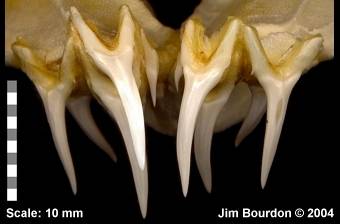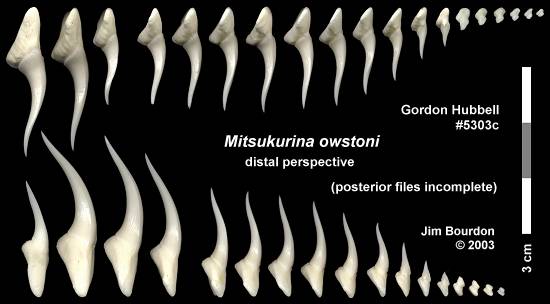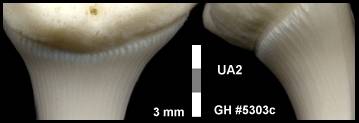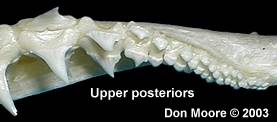 Reviewing available dentitions, there are consistently three upper anterior teeth. Only two (Hubbell) specimens have an additional small upper symphyseal-like tooth. The third upper anterior tooth is variable in that the cusp, although almost always being straight, may either be perpendicular to the root, or it may slant as much as 25 degrees laterally (none have been slanted medially). The medial root lobe of the third upper anterior is elongated, and in some specimens is greatly elongated making the width of the root greater than the total height of the tooth. There also may be a diastema between the second and third upper anteriors equal to the width of the root of the third upper anterior.
Reviewing available dentitions, there are consistently three upper anterior teeth. Only two (Hubbell) specimens have an additional small upper symphyseal-like tooth. The third upper anterior tooth is variable in that the cusp, although almost always being straight, may either be perpendicular to the root, or it may slant as much as 25 degrees laterally (none have been slanted medially). The medial root lobe of the third upper anterior is elongated, and in some specimens is greatly elongated making the width of the root greater than the total height of the tooth. There also may be a diastema between the second and third upper anteriors equal to the width of the root of the third upper anterior.Contrary to the interpretation of the senior author, Gordon preferred to interpret the tooth from the first file position as a symphyseal (followed by three lower anterior teeth).
Only three percent of the Mitsukurina dentitions had one or more intermediate teeth. The accompanying images represent examples of one (upper RH) and two (upper LH) intermediates and their associated A3 and L1 neighbors.

Viewed laterally, the lateroposteriors are remarkably similar. By contrast, the lower anteriors are lingually directed quite strongly when compared to their upper counterparts.

| Striations Although difficult to see in the accompanying images, the lingual face of the teeth are strongly striated. These ridges closely spaced, quite regular and extend nearly to the apex. |
 |
Lateral cusplets may or not be present on Mitsukurina teeth. The accompanying image, shows teeth from two dentitions. The upper (GH #5303c) lacks cusplets in more forward file positions while reflecting them in rear files. The lower examples (GH #5303d) bear cusplets even into anterior file positions.

The available material reflects that many dentitions have more delicate teeth than others — a variation that is quite striking. Since these sharks were in the three to four meter range, this is unlikely to be an ontogenetic variation. Sexual dimorphism might be an explanation, however the Taiwanese fishermen claimed they were males. There is great room for speculation on this point, but too little is known, and that mostly hearsay.

After having the luxury of looking at so many Goblin jaws from sharks that were all caught in the same place at the same time, we can say that there is an extreme amount of variation in tooth structure among these specimens. Some have very long thin teeth, and others have stouter teeth much like a sand tiger (Carcharias). For example the enamel measurements on the third lower file of two specimens are as follows: width at mid-point between the tip and the base is 2.5 mm and the total height of the crown (straight line) is 27 mm. On another specimen the mid-point width is 3.5 mm and the total crown height is 22 mm.
| Posteriors Posterior teeth are numerous and small. The precise count is variable, however lowers tend to out number uppers, which have been noted to range from eight to over a dozen. |
 |